Electric air taxis are quickly approaching full readiness for zero-emission city hops, promising faster, quieter, and eco-friendly urban travel. Leading companies like Joby Aviation and Volocopter are testing in real-world pilot programs, focusing on safety, battery technology, and regulatory approval. These innovative aircraft aim to reduce traffic congestion and pollution while integrating into existing airspace systems. Stay tuned to discover how this emerging technology will soon transform your city’s transportation landscape.
Key Takeaways
- Leading companies like Joby Aviation and Volocopter are conducting pilot programs to test urban air taxi capabilities.
- Battery advancements enable longer, more efficient flights with quick charging, supporting zero-emission city hops.
- Regulatory frameworks and safety standards are evolving to certify electric air taxis for commercial urban use.
- Infrastructure development, including charging stations and vertiports, is underway to facilitate widespread adoption.
- Growing market interest and technological progress position electric air taxis as a viable zero-emission urban transportation solution.
The Rise of Urban Air Mobility
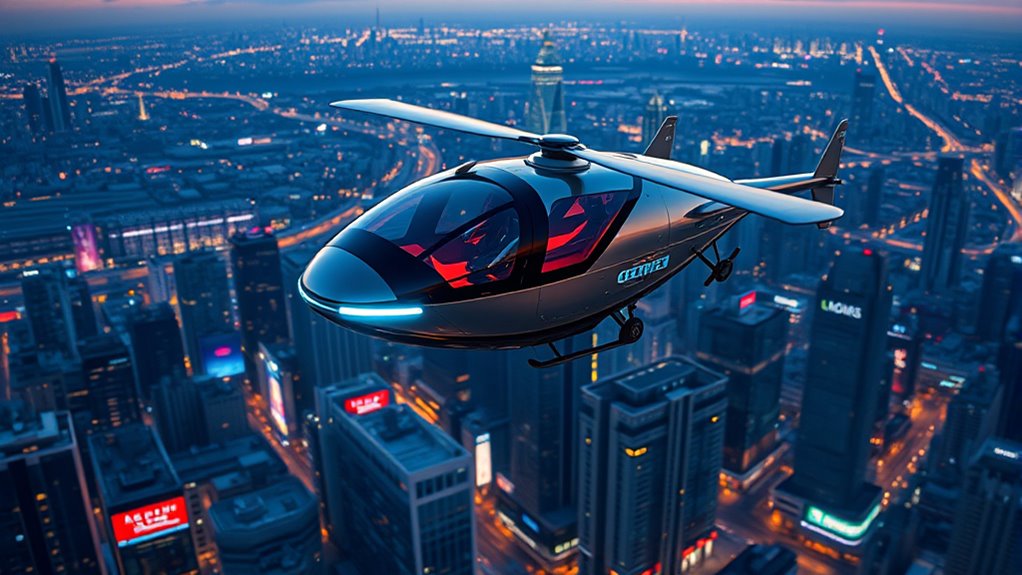
Have you noticed how traffic congestion is getting worse in cities around the world? Urban congestion can make commuting frustrating and time-consuming, but electric air taxis aim to change that. By taking to the skies, these aircraft promise to dramatically reduce travel times and ease street-level traffic. As a passenger, you’ll experience a smoother, faster journey without the gridlock. Urban air mobility is becoming a reality, offering a new way to navigate busy cityscapes efficiently. This shift not only improves your passenger experience but also helps decongest crowded streets. With electric air taxis, cities are opening up new possibilities for quick, eco-friendly travel above the chaos below. It’s a bold step toward transforming urban transportation and making city commutes more manageable. Additionally, predictive analytics can assist in optimizing routes and operational efficiency for these new transportation modes.
Key Technologies Powering Electric Air Taxis
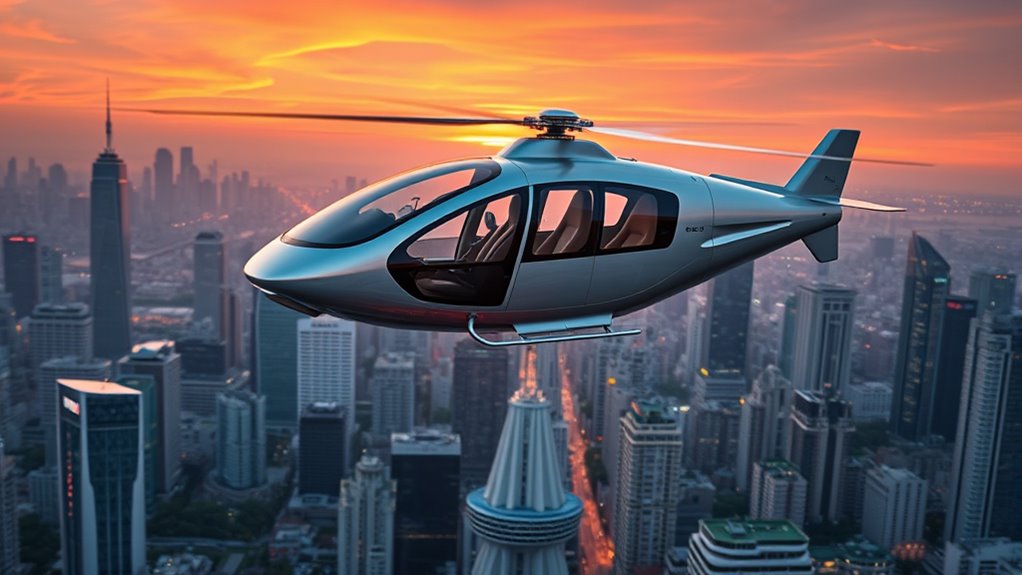
The development of electric air taxis relies on a combination of advanced technologies that enable safe, efficient, and reliable flight. Battery innovations play a essential role, providing higher energy density, faster charging, and longer lifespan, which are indispensable for practical urban mobility. These improvements allow the vehicles to fly longer distances without added weight or bulk. Propulsion systems are equally critical, with electric motors offering quiet, responsive, and efficient power delivery. Modern propulsion setups often feature multiple rotors or ducted fans, ensuring stability and safety during flight. Together, battery innovations and sophisticated propulsion systems form the backbone of electric air taxis, supporting their ability to operate environmentally friendly, cost-effective, and scalable urban transportation solutions. Additionally, high refresh rates in onboard systems help maintain real-time responsiveness, crucial for urban navigation and safety.
Environmental Benefits and Sustainability Goals
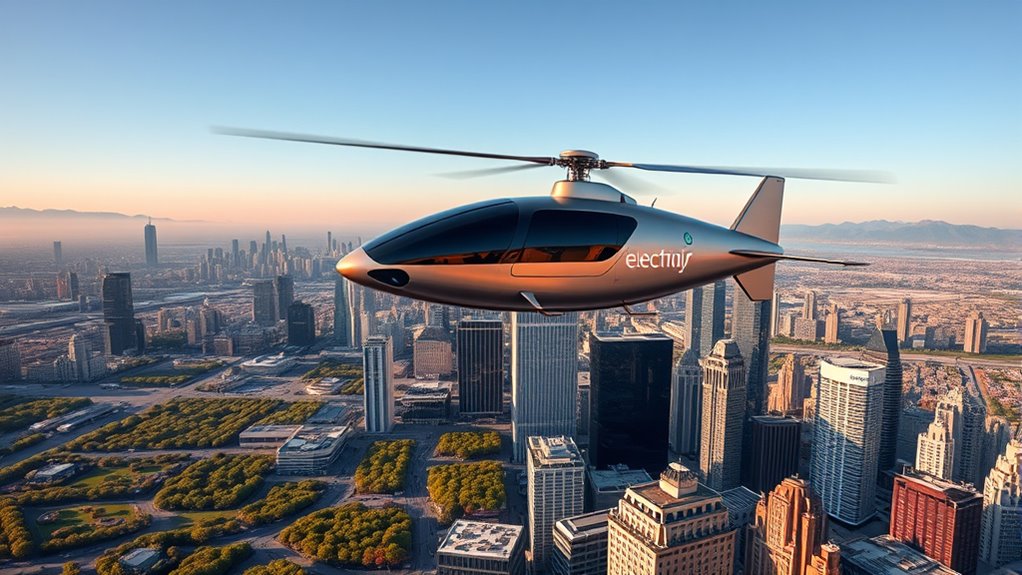
Electric air taxis substantially reduce environmental impact by cutting greenhouse gas emissions and reliance on fossil fuels. They support sustainability goals by promoting cleaner transportation options and lowering urban pollution. To maximize their eco-friendly benefits, manufacturers focus on:
- Implementing battery recycling programs to minimize waste and resource use
- Using renewable energy sources to charge batteries, reducing carbon footprint
- Designing energy-efficient aircraft to lower overall power consumption
- Encouraging sustainable urban planning that integrates electric mobility solutions
These efforts help guarantee electric air taxis contribute to a greener future. By prioritizing renewable energy and responsible battery management, you can achieve significant progress toward zero-emission city hops. Their adoption aligns with global sustainability goals, making urban air mobility both practical and environmentally responsible.
Leading Companies and Current Pilot Programs
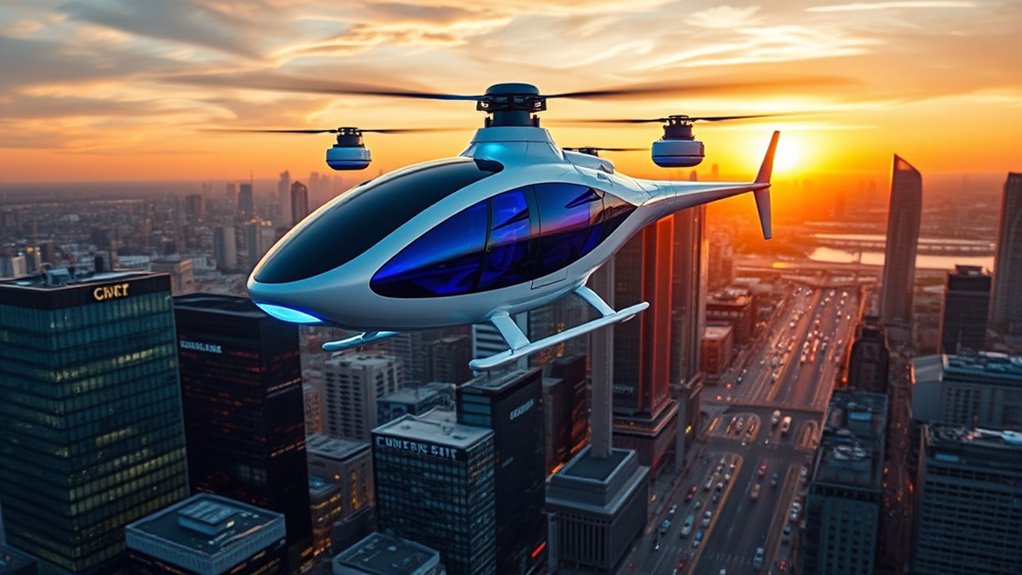
Several leading companies are pioneering electric air taxi technology through innovative pilot programs that test their capabilities in real-world settings. These programs focus on improving battery technology to extend flight range and reduce charging times, making urban air mobility more practical. As cities grapple with urban congestion, these pilots demonstrate how air taxis can provide efficient, zero-emission alternatives for short-distance travel. Companies like Joby Aviation, EHang, and Volocopter are deploying test flights in cities worldwide, gathering data on performance and safety. Their efforts aim to validate the viability of electric air taxis as a solution to traffic jams, offering faster, cleaner, and more flexible transportation options. These pilot programs mark a critical step toward integrating electric air taxis into everyday urban mobility. Additionally, ongoing research into battery advancements is essential for enhancing flight endurance and operational efficiency in these urban environments.
Regulatory Frameworks and Safety Standards
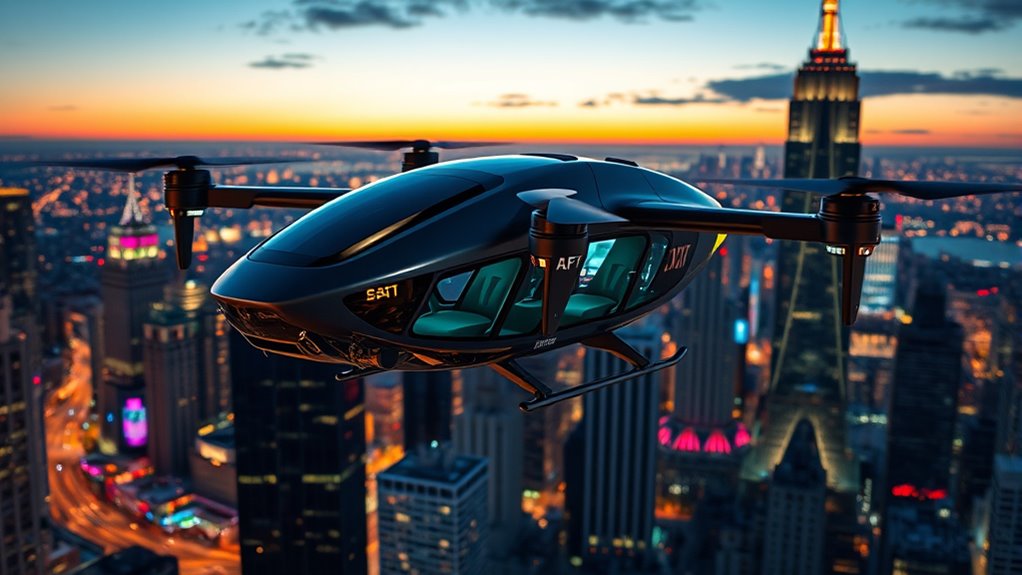
You need to understand how certification processes and criteria guarantee electric air taxis meet safety standards before they take off. Integrating these vehicles into existing air traffic management systems poses logistical challenges that require careful planning. Additionally, complying with evolving regulations can be complex, but it’s essential for safe and lawful operation. Ensuring safety standards are consistently met is crucial for public trust and operational success.
Certification Processes and Criteria
Establishing certification processes and criteria for air taxis is essential to ensuring their safety and reliability before they hit the skies. You need clear guidelines to verify that each craft meets strict safety standards, including structural integrity and emergency systems. Battery certification plays a vital role, ensuring batteries are reliable, safe, and capable of handling repeated charges without failure. The process involves rigorous testing for fire resistance, durability, and performance. Certification also assesses pilot training requirements and operational procedures. You’ll find that approval timelines depend on compliance with these standards, which are regularly updated to incorporate new technology and safety insights. By adhering to these criteria, manufacturers demonstrate their commitment to safety, making air taxis trustworthy options for zero-emission city hops. Regularly updating safety standards helps incorporate the latest advancements and best practices in the industry.
Air Traffic Management Integration
Integrating air taxis into existing air traffic management systems requires thorough regulatory frameworks and strict safety standards to prevent collisions and ensure smooth operations. As these vehicles enter urban airspace, you need clear protocols for managing increased air traffic density. Establishing standardized procedures helps coordinate takeoffs, landings, and routing, reducing risks in busy city skies. Regulatory agencies must adapt current air traffic systems to accommodate low-altitude, vertical mobility. Implementing real-time communication and tracking ensures pilots and controllers stay aware of each other’s positions. Safety standards must also cover emergency procedures, maintenance, and pilot training tailored for urban airspace. By creating a cohesive management system, you enable safe, efficient integration of air taxis into the urban environment, paving the way for a reliable zero-emission transportation network. Additionally, fostering attention during operations enhances safety and efficiency in these complex environments.
Regulatory Compliance Challenges
As electric air taxis become a reality in urban skies, steering the complex landscape of regulatory compliance presents significant challenges. You must navigate evolving safety standards and certification processes to guarantee passenger safety and operational legitimacy. Battery safety is vital, requiring rigorous testing and standards to prevent fires or failures. Pilot licensing also demands clarity, with authorities establishing specialized credentials for operating these new aircraft. Additionally, you’ll need to address airspace integration, noise regulations, and emergency protocols. Developing uniform safety standards for batteries and systems, creating pilot licensing frameworks tailored to electric vertical takeoff and landing aircraft, establishing clear certification procedures for manufacturers, and ensuring compliance with evolving airspace regulations and safety protocols are all crucial steps. Furthermore, addressing cybersecurity vulnerabilities and implementing security measures will be essential to protect these vehicles from potential cyber threats.
Challenges and Limitations to Deployment

You’ll face significant regulatory and safety hurdles as electric air taxis move toward widespread use. Building the necessary infrastructure and managing costs also pose major challenges that can slow deployment. Addressing these issues is essential for making air taxis a viable transportation option. Additionally, developing sound recording techniques to ensure clear communication and navigation during flight operations will be critical for safety and efficiency.
Regulatory and Safety Barriers
What hurdles stand in the way of deploying electric air taxis at scale? Regulatory and safety barriers are significant. Governments need to develop new rules for aircraft certification, air traffic management, and pilot training. Ensuring safety is paramount, but it slows down approval processes. Public acceptance also poses a challenge, as people worry about privacy concerns and potential accidents. Key issues include:
- Establishing exhaustive safety standards and certification processes
- Gaining public trust amidst privacy concerns and safety fears
- Creating clear regulations for urban airspace management
- Ensuring seamless integration with existing air traffic control systems
Addressing product reviews and ensuring consistent quality is also essential to public confidence. Without clear regulations and safety assurances, widespread adoption stalls. Overcoming these barriers requires collaboration between regulators, manufacturers, and communities to address safety and privacy, paving the way for smoother deployment.
Infrastructure and Cost Challenges
Building the infrastructure needed for electric air taxis presents substantial challenges that can hinder large-scale deployment. You’ll need a network of reliable charging stations at vertiports and strategic locations, which requires significant investment and planning. The costs of installing these stations can be high, especially in densely populated urban areas. Additionally, maintenance costs for both the charging infrastructure and the aircraft themselves can add up quickly, impacting overall affordability. Ensuring consistent power supply and rapid charging capabilities is essential for operational efficiency, but it demands advanced technology and infrastructure upgrades. These financial and logistical hurdles can slow down adoption, making it essential for stakeholders to carefully evaluate infrastructure development and maintenance expenses before scaling up electric air taxi services. Proper planning for energy storage and backup power systems is also critical to address potential power supply disruptions.
Future Outlook and Market Potential
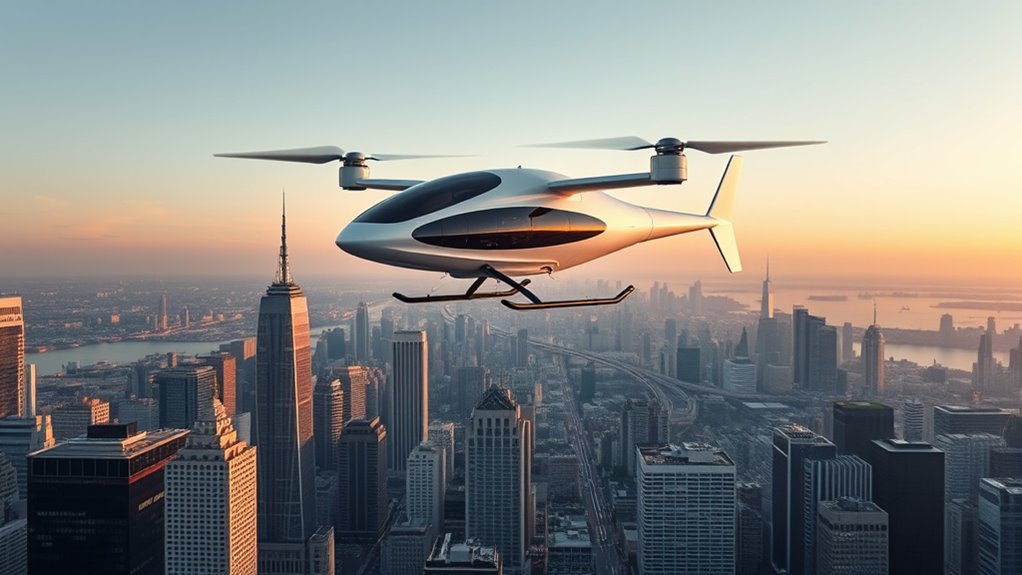
The future of electric air taxis looks promising as advancements in battery technology and autonomous systems continue to accelerate. You can expect significant market growth driven by increasing demand for faster, eco-friendly urban transport. Investment opportunities are expanding, attracting both startups and established companies. As regulations evolve, the industry will benefit from supportive policies and pilot programs. Key factors shaping the outlook include:
- Rapid technological innovation boosting safety and efficiency
- Rising urban congestion prompting demand for aerial solutions
- Decreasing costs making electric air taxis more accessible
- Growing interest from investors seeking sustainable mobility options
With these trends, the market potential for electric air taxis is substantial, positioning them as a viable, zero-emission alternative for city travel. The coming years will likely see widespread adoption and further investment.
How Electric Air Taxis Will Transform City Travel
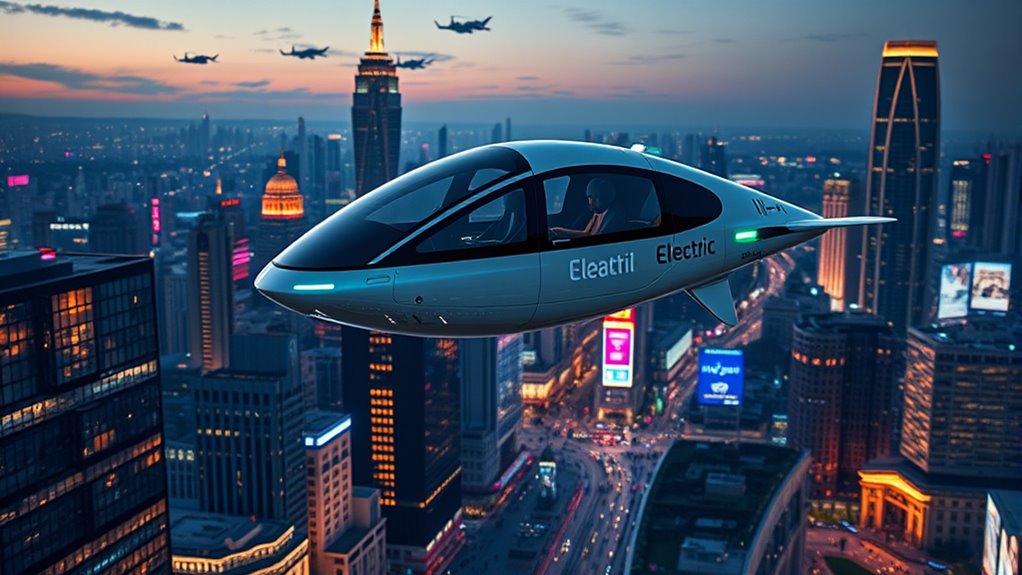
Electric air taxis are poised to revolutionize city travel by providing a fast, flexible alternative to ground transportation. With ongoing battery advancements, these vehicles can achieve longer ranges and faster charging times, making them practical for daily use. As urban congestion worsens, electric air taxis will help alleviate traffic jams by offering aerial routes that bypass gridlock. You’ll experience quicker commutes, especially during peak hours, reducing travel time considerably. Their ability to take off and land vertically means they can operate from small urban spaces, integrating seamlessly into cityscapes. This shift will transform how you move around, making city travel more efficient, less stressful, and environmentally friendly. Electric air taxis promise a new era of mobility that addresses current transportation challenges head-on.
Frequently Asked Questions
What Are the Estimated Costs for Consumers to Use Electric Air Taxis?
You’re likely wondering about the cost estimates for electric air taxis. While fares vary depending on the provider and distance, most companies aim for a competitive fare structure to attract riders. Expect initial prices to be somewhat high but decrease as technology advances and demand grows. Overall, you can anticipate a convenient, eco-friendly option that offers a reasonable fare, making city hops quicker and more affordable over time.
How Will Urban Infrastructure Adapt to Support Air Taxi Takeoff and Landing?
You might think cities already have enough on their plates, but now they’ll need vertiport design to support air taxis. Urban landscapes will transform, with rooftops and parking lots becoming new hubs for takeoff and landing. Ironically, as cities grow busier, they’ll carve out space for these sleek vehicles, blending the sky’s new role into the urban fabric. It’s a futuristic twist on urban planning you never saw coming.
What Training Will Pilots Require to Operate Electric Air Taxis Safely?
You’ll need specialized pilot certification for electric air taxis, focusing on their unique systems and flight dynamics. Training will cover emergency protocols specific to electric aircraft, like battery management and rapid response procedures. You’ll also practice handling in-flight emergencies and safe takeoff and landing techniques. This thorough preparation guarantees you’re equipped to operate these eco-friendly taxis safely, maintaining passenger safety and adhering to aviation standards.
How Will Air Traffic Control Coordinate With Urban Air Mobility Vehicles?
Did you know urban air mobility vehicles could increase city traffic efficiency by up to 60%? Air traffic control will play a vital role in coordinating these vehicles, ensuring safe and smooth urban mobility. Controllers will use advanced radar, AI, and real-time data to manage airspace, integrating traditional aircraft with air taxis seamlessly. This coordination will help reduce congestion, improve travel times, and make city skies safer for everyone.
What Are the Potential Privacy Concerns Associated With Electric Air Taxis?
When considering privacy concerns with electric air taxis, you should be aware that data privacy and surveillance worries come into play. These vehicles collect and transmit data for navigation and safety, which could lead to unauthorized surveillance or data breaches. You might feel uneasy about who has access to your flight information or personal details, making it vital for regulations to safeguard your privacy and ensure responsible data handling.
Conclusion
Electric air taxis are launching us into a new era of city travel, like birds breaking free from the ground. With advancements in technology and a focus on sustainability, you’ll soon glide above traffic jams effortlessly. While challenges remain, the sky’s the limit for urban air mobility. Embrace this flight toward a cleaner, faster future—your journey to smarter city travel is taking off, and the horizon has never looked brighter.










